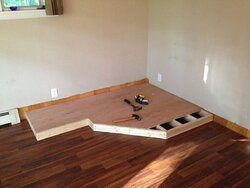I've been lurking for almost a year now and finally registered today, with impending mountain of questions.
Just Acquired
- Alderlea T5, to be delivered and installed on the 23rd (thanks to ~50 posts that swayed us in this direction)
- Seasoned hardwood, 2 cord, sitting on the asphalt driveway, just delivered (2 more in the next couple weeks with next year's wood soon after)
Items in progress:
hearth pad build
Work to do:
wood stacking method
remove baseboard heater
decide on mantle locations
We had the pad designed (1.5" tall) and while at the store to buy supplies we started to doubt our height decision and left to rethink. We've now decided to raise the hearth up on 2x4's, for aesthetic reasons. Finished height will be 5 1/8".
Our stove only requires ember protection, with a nice 4" clearance to the back wall, so most of this is purely to make the stove look like a more permanent feature in the house.
Here's our build plan, with photos below.
2x4 frame
3/4" plywood
1/8" white thinset
1/4" hardibacker
1/8" white thinset
3/8" tumbled travertine tile
- mix of large/small squares and rectangles on 12x12 mesh
- sealed before and after grouting
polyblend fawn colored grout
- we're not sure what we're going to use for the sides of the frame, recommendations welcome.
Questions:
1) Plan is to space 2x4's 16" on center, running perp to the floor joists below - sound reasonable? Anything special needed under the feet of the stove?
2) Any recommendations for the sides? We looked at molding but didn't see any tall enough, so current thinking is to rip a 1x6 to 1x5.25" and router the outside edge
3) we're resolved to removing a section of the baseboard heater, which will cost over $350 to have done. Any creative solutions to this issue?
4) we're debating on the electrical outlets. pros/cons to keeping/removing them?
5) anyone install lighting in the stone work above the stove? would want to do wiring prior if it makes sense
I can't wait to get the stove in and even enjoyed throwing the firewood around today. Having grown up in northern MN, this feels like home.
Wish me luck and feel free to comment/question on anything I've written. Most decisions made so far came from reading posts on this forum. Thank you.
![IMG_20130906_102635_720[1].jpg IMG_20130906_102635_720[1].jpg](https://www.hearth.com/talk/data/attachments/110/110857-5957d4b89fefd605c983a5dceef2f77e.jpg)
![IMG_20130907_115848_495[1].jpg IMG_20130907_115848_495[1].jpg](https://www.hearth.com/talk/data/attachments/110/110858-0083fb456402e681bb8b0431dc024687.jpg)
![IMG_20130908_184002_366[1].jpg IMG_20130908_184002_366[1].jpg](https://www.hearth.com/talk/data/attachments/110/110859-678a9475e62793b88f2382a71367f8c8.jpg)
![IMG_20130908_185903_625[1].jpg IMG_20130908_185903_625[1].jpg](https://www.hearth.com/talk/data/attachments/110/110865-9d510c0066c9282a8c16e17be22ebd45.jpg)
Just Acquired
- Alderlea T5, to be delivered and installed on the 23rd (thanks to ~50 posts that swayed us in this direction)
- Seasoned hardwood, 2 cord, sitting on the asphalt driveway, just delivered (2 more in the next couple weeks with next year's wood soon after)
Items in progress:
hearth pad build
Work to do:
wood stacking method
remove baseboard heater
decide on mantle locations
We had the pad designed (1.5" tall) and while at the store to buy supplies we started to doubt our height decision and left to rethink. We've now decided to raise the hearth up on 2x4's, for aesthetic reasons. Finished height will be 5 1/8".
Our stove only requires ember protection, with a nice 4" clearance to the back wall, so most of this is purely to make the stove look like a more permanent feature in the house.
Here's our build plan, with photos below.
2x4 frame
3/4" plywood
1/8" white thinset
1/4" hardibacker
1/8" white thinset
3/8" tumbled travertine tile
- mix of large/small squares and rectangles on 12x12 mesh
- sealed before and after grouting
polyblend fawn colored grout
- we're not sure what we're going to use for the sides of the frame, recommendations welcome.
Questions:
1) Plan is to space 2x4's 16" on center, running perp to the floor joists below - sound reasonable? Anything special needed under the feet of the stove?
2) Any recommendations for the sides? We looked at molding but didn't see any tall enough, so current thinking is to rip a 1x6 to 1x5.25" and router the outside edge
3) we're resolved to removing a section of the baseboard heater, which will cost over $350 to have done. Any creative solutions to this issue?
4) we're debating on the electrical outlets. pros/cons to keeping/removing them?
5) anyone install lighting in the stone work above the stove? would want to do wiring prior if it makes sense
I can't wait to get the stove in and even enjoyed throwing the firewood around today. Having grown up in northern MN, this feels like home.

Wish me luck and feel free to comment/question on anything I've written. Most decisions made so far came from reading posts on this forum. Thank you.
![IMG_20130906_102635_720[1].jpg IMG_20130906_102635_720[1].jpg](https://www.hearth.com/talk/data/attachments/110/110857-5957d4b89fefd605c983a5dceef2f77e.jpg)
![IMG_20130907_115848_495[1].jpg IMG_20130907_115848_495[1].jpg](https://www.hearth.com/talk/data/attachments/110/110858-0083fb456402e681bb8b0431dc024687.jpg)
![IMG_20130908_184002_366[1].jpg IMG_20130908_184002_366[1].jpg](https://www.hearth.com/talk/data/attachments/110/110859-678a9475e62793b88f2382a71367f8c8.jpg)
![IMG_20130908_185903_625[1].jpg IMG_20130908_185903_625[1].jpg](https://www.hearth.com/talk/data/attachments/110/110865-9d510c0066c9282a8c16e17be22ebd45.jpg)



![IMG_20130923_131336_550[1].jpg IMG_20130923_131336_550[1].jpg](https://www.hearth.com/talk/data/attachments/112/112504-5a42fcfbc86384bd914501c953f16edb.jpg)
![IMG_20130923_193631_756[1].jpg IMG_20130923_193631_756[1].jpg](https://www.hearth.com/talk/data/attachments/112/112505-48afcfded0a529c68bb2590cd88198e2.jpg)